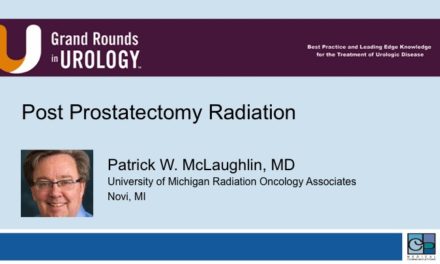Dr. Alan W. Partin presented at the 26th International Prostate Cancer Update on Thursday, January 21, 2016 on “Active Surveillance at Johns Hopkins – Update 2015.”
Keywords: prostate cancer, active surveillance, resistance, biopsy, fluoroquinolone
How to cite: Partin, Alan W. “Active Surveillance at Johns Hopkins – Update 2015.” Grand Rounds in Urology. January 21, 2016. Jan 2025. https://dev.grandroundsinurology.com/active-surveillance-johns-hopkins-update.
Transcript
Active Surveillance at Johns Hopkins – Update 2015
Active surveillance is getting more and more popular among the discussions that we’re having with our patients that are just coming in. What I wanted to present today is the 20-year update of our active surveillance program at Johns Hopkins.
On my first slide was a picture of Ball Carter who most of you have heard of, or even know. This is his work over the last two decades, although I take care of about a third of the patients, and most of the statistics and the data were generated by Ball Carter’s research. So, that’s Ball Carter, giving him credit for what I’m going to show you today. Disclosure with active surveillance, none, because you really don’t do much with the patients.
Strategy for reducing over-treatment of prostate cancer is really what active surveillance was originally about. Three things you have to remember about that is it is a management option for those patients who are fit for curative intervention. It is a selection of men who are at a low risk of harm if they’re not treated, and finally, if that delayed curative intervention, they have to be somebody who is going to benefit from that.
We’re going to get into this new definition now. We had for many, many years patients at low risk of progression, and now we have very low risk. So, big question–and this was published in 2011; a couple of other papers have come out–is how often are life-threatening cancers misclassified as insignificant, and with the pathologic feature of having a Gleason 7 non-organ confined, or a high Gleason, and/or an SV or lymph node involvement.
Using the Epstein criteria for Caucasians, a high-risk cancer is missed only 2% of the time; for African-Americans it was 5%, and when you throw MRI into the story, Turkbey published that it’s about 3% in a group of 133 patients. So, not very often, or “life-threatening cancers” missed by the definition for active surveillance. We now use a lot of multi-perimetric MRI for active surveillance patients. One for selection, trying to reduce great misclassification, and many studies have now shown that this multi-perimetric, which we just heard about, fusion biopsy, has a higher sensitivity for picking up high-grade cancers, as compared to our TRUS-guided systematic random biopsies.
We also use it for monitoring. We want to reduce the number of surveillance biopsies. After a patient has had five biopsies with not evidence of progression we begin to use the MRI alone as a method for looking if they’re going to need another one. We clearly have found out you don’t have to do an MRI every year. Things just don’t change that fast. That’s been published by several other groups, as well.
These are the criteria for selection in the very low-risk category. If your PSA is less than 10, non-palpable disease, your density’s less than 0.15, no Gleason 7, less than 3/4 and it’s on one side of the prostate. If they’re life expectancy is less than 20 years, and again that was a question we were getting at earlier; do you really need an MRI? But, if their PSA is a little higher and they’re the guy that has that really big prostate that you’re worried about because his density is very low, and MRI is absolutely indicated for those men.
Then you go to the low risk category; those are the 21Cs or the T2As, Gleason less than 7, PSA less than 10, if they’re life expectancy is less than 10, surveillance is preferred, and we get MRIs on all those men. Intermediate risk prostate cancer, we’re not really following many of these men with active surveillance, but if they have a very low life expectancy you could or could not get an MRI before doing their biopsy.
Then monitoring men after they’ve taken part in the active surveillance program. We bring them in every six months. This an ongoing 20-year research program, so we collect serum, urine, do digital rectal exams on the patients, and they kind of feel a warm cozy feeling about being seen twice a year.
Our biopsies are either 12 or 14 depending on if it’s–as we heard just in the previous talk–something that MRI suggested you go after. We do it once a year for those patients that are low risk, if they have a greater than 10-year life expectancy. If they’re very low-risk and the PSA is greater than 10, we do it every year. We do it twice a year for those men that are very low-risk and there’s definitely no suspicious areas on the MRI. We get the MRI twice a year after we’ve decided to stop getting prostate biopsies.
What are our triggers for curative intention on active surveillance? One, and the most common one I see, is the patients’ preference, after a period of time a lot of these guys decide they’re beginning to get older, more comorbidities, and they’re worried that they’ll lose that window of opportunity, so we see a lot of patient preference.
Reclassification of risk, going from low to very low, in someone that has a long life expectancy, you get a little more nervous about that. Or, if a Gleason 7 shows up. PSA at 10-20, and they’re now going into the low-risk category, or if the PSA gets above 20, those are the biggest trigger warnings to try to drop out of active surveillance.
Just a quick look at our active surveillance cohort. The median follow-up is five years. The inter-quartile range 2-7, but almost 7,000 person years in this cohort of 1,368 men starting in 1995. You can see the distribution by age of the very low-risk men who are 70% of our cohort, and the low risk, which are 30%.
Those of you that are familiar with Laurie Klotz’s Toronto group, this is a totally different group of men, he has intermediate risk patient in his cohort, and probably over 50% of them that are low-risk, which does explain some of the differences in the progression rates when you look at them.
This is looking at the whole group over the first 15-20 years. The dotted line is biopsy reclassification by grade only; about 30%. Biopsy reclassification for any reason is about 57%, and then, obviously, the ones that reclassify you can see in the solid gray line, are ones that end up getting treated.Looking at hazard of death, almost no deaths; less than 0.1%. You can see death from other causes. These are relatively healthy men, because only about 22% of them actually died from any cause over the 17-year follow up there.
This was a study we get asked a lot about; fluoroquinolone resistance, which is important for all biopsies, but since active surveillance patients are getting multiple prostate biopsies year after year we were able to find out, were we reducing resistance? Were the patients originally resistant, did they change? Or if they weren’t, did it become–and this was presented by one of our medical students who’s now a resident. This was at the 2014 AUA. So, the rising rate of infections related to prostate biopsies lead to many hospitalizations. Stacey Loeb has published several good papers on this; they’re worth reading.
The increase is mostly due to that well-known fluoroquinolone resistance in our rectal flora. Resistance rates can rise as high as 20%, and then undergoing TRUS biopsy, that resistance is associated with diabetes, heart valve replacement, or use of the fluoroquinolone recently. The longitudinal trends in resistance within the individual person were not well-characterized before this study.
So, what we do, and we now do this for every biopsy, not just active surveillance patients, patient receives a rectal swab and it’s plated for fluoroquinolone resistance. The patients that are coming from out of town, we’ve even worked out a way to mail them the cultured Q-tip and they mail it back to us; it seems to work quite well. If there’s no growth we use the fluoroquinolone for the biopsy if they’re not allergic to it.
Then if there is a bacterial growth under fluoroquinolone culture, our lab plates a whole panel of other antibiotic tablets onto it, then gives us a report and basically tells us what we should use for their prostate biopsy. We’re using targeted prophylaxis for that.
I have to tell you, probably in the last year-and-a-half to two years I have not seen an infection, or a fever and shaking chills in one of our patients, just by this simple test. It’s hard to get your lab to do it, but once you do, you’ll be happy about that.
So, in this study cohort, these were men in our active surveillance program. The comparison group were patients that were getting prostate biopsies that weren’t in the active surveillance group, and they were not getting the rectal swab done at that time.
Here you can see the active surveillance cohort, their age, number of cultures that we obtained, and the number of resistants were pretty much the same. So, it’s a comparatively equal group. An interesting fact, we found that among men who are fluoroquinolone resistant on their swab, a high percentage of them were also resistant to Bactrim and aminoglycosides as well, which kind of surprised us and showed even more the importance of getting a panel instead of just deciding to give everybody genomyocin.
This is the association of resistance and the biopsy history in the active surveillance cohort. The median time from biopsy to swab, no difference. TRUS biopsy having been performed within the last 12 months, no difference. TRUS biopsy in the last 6 months, no difference.
Does this resistance increase with increasing number of biopsies? And you can see across the bottom and getting from 1-7 prostate biopsies, it doesn’t appear that there’s more fluoroquinolone resistance in the patients that got 7 versus the one that got one, and the P value was only 0.1.
Factors associated with the resistance, just most important, diabetes was really among this cohort, the only significant finding associated with resistance. 4.5% of those that were sensitive versus 15.7% of those that were resistant, and under multi-variated analysis diabetes was a significant factor, so these are the men you want to play close attention to.
So, in the group, looking at the data real quickly, 416 men, 23% resistant, 77% sensitive. All the men underwent a second swab, and those that were resistant, 76 were still resistant. Those that were sensitive to fluoroquinolones under the second swab for their second biopsy, we still had 91% of them stayed sensitive. It appears that once you obtain resistance it probably sticks with you, and if you’re sensitive on the first, you’re very likely to still be sensitive on the next. We also do one for every biopsy, though.
So, in conclusion, 1 in 4 men presenting for prostate biopsy at our institution were resistant to fluoroquinolone. The resistance rates were not higher among the men in the active surveillance compared to men undergoing their initial diagnostic biopsies. Multiple biopsies were not associated with increased fluoroquinolone resistance. Diabetes was the number one risk factor, and most men that carried the fluoroquinolone resistance remained resistant over time.
Just to summarize quickly; we initiated the program in 1995. As of September 2014 there were about 1,300 men. We showed you the follow up and the person years. It’s quite a large cohort right now. It really changes your practice, I’ll tell you. All these men have to keep coming back every six months to see you, and it’s a lot of prostate biopsies.
That’s our distribution with low and very low. We already looked at these classification rates, but you can see the numbers one more time over 5, 10, and 15 years based on any reason, grade, and our treatment rate gets up higher.
Men with favorable risk disease consider active surveillance should be informed that they have about a 4-6% of reclassification to high-grade; about only 1% chance of death over the 15-year period. We’ve already covered that. This is the group that works on the active surveillance at Johns Hopkins, and Ball Carter runs.
ABOUT THE AUTHOR
Dr. Partin is the Jakurski Family Director and Professor of Urology at Johns Hopkins in Baltimore, Maryland. He is the author or co-author of more than 500 scientific articles, serves on numerous editorial boards, and is Editor-in-Chief of Urology Case Reports and editor of the Campbell-Walsh urology text. He has been honored with many awards, including the Hopkins Young Investigators Award, the Pfizer Scholars in Urology Award in 1996, and the “Gold-Cystoscope” award in 2001. In 2004, Dr. Partin was named Director of the Department of Urology at the James Buchanan Brady Urological Institute and Urologist-in-Chief of Johns Hopkins Hospital.
Dr. Partin is an expert in assessing prognosis and making predictions for men with prostate cancer. The creation of The Partin Tables, which can predict with 95 percent accuracy a man’s likelihood of being cured by treatment, made his research famous. Dr. Partin’s laboratories focus on developing and testing new and existing methods for predicting the aggressiveness of prostate cancers so that rational treatment decisions can be made by both patients and physicians.
Dr. Partin’s laboratories have investigated many new “PSA-like” serum tests, some of which are soon to become available for the diagnosis of prostate cancer as well as basic science investigation of new proteins—which may help in detection—and staging of prostate cancer. In addition, Dr. Partin has an academic and clinical interest in the treatment of benign prostatic hyperplasia with an emphasis on minimally invasive techniques.
Dr. Partin received his undergraduate degree in Chemistry from the University of Mississippi, where he was an Academic All-American football player. He received his medical degree and his PhD in Pharmacology and Molecular Sciences from Johns Hopkins University, where he continued his postdoctoral training.





